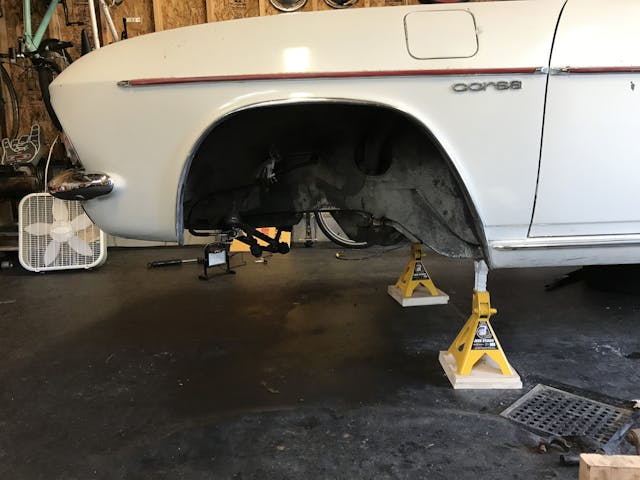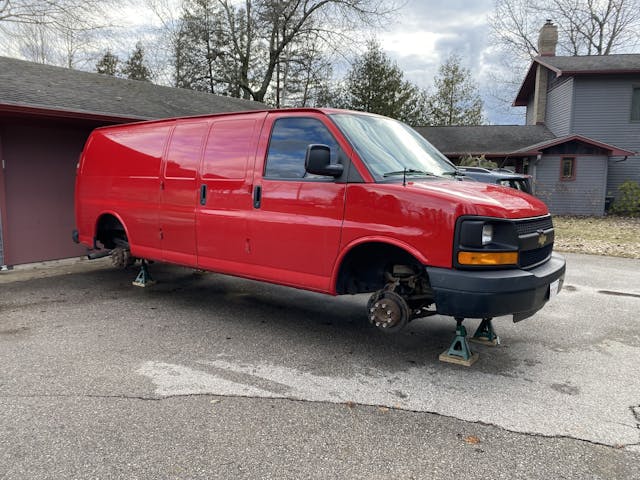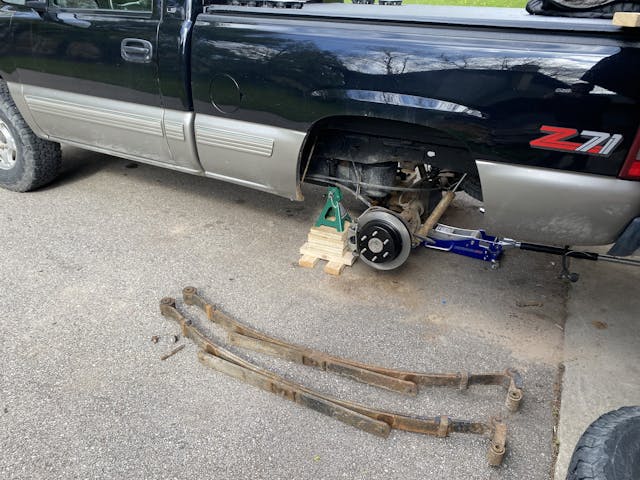6 tips for using jack stands
Working on cars requires a whole slew of relatively specialized tools. Often times we don’t even realize how unique those tools and practices are until we talk to someone new to the hobby. Or someone who is on the outside looking in. Just one example: How casually we discuss (and practice) the act of lifting our multi-thousand pound vehicles into the air and then supporting them with separate load-bearing apparatuses that allow us to work on, disassemble, or reach under the vehicles. It’s dangerous when done right, and deadly when done wrong.
That sounds scary, and to a point it should be. Being cautious when the risks are this high is not a bad thing. That’s why we created a quick list of tips for using jack stands: good for newbies, but it’s also a refresher for those experienced enough to have lifted up a vehicle many times, in many ways over the years.
Buy once, cry never

There are many factors in selecting jack stands, and price is one that many of us are forced to consider. While tools can and will be shopped based on price point, jack stands should not be one of them. These are critical safety items that should come from reputable and trustworthy sources. The Harbor Freight jack stand debacle of 2020 should be burned in our collective memory for a long time, as being crushed by your car is not the way to go. Cheaping out with jack stands is a fast track to a mere feeling of safety, rather than possessing actual safety.
Jack stands should be sturdy with a good wide base. A secondary method of locking them at the desired height is also a plus. Do not modify jack stands or otherwise compromise safety features in the name of convenience. Doing so is only making it easier to get hurt.
Size appropriately

Jack stands produced after 2015 are rated as a pair. Which means if you find some at the local parts store that say they are “three-ton” jack stands, the ability to support the claimed 6000 pounds requires both stands. In reality, three-ton jack stands should be the smallest used in most home shops, as it gives a good safety margin when working on smaller cars, yet a set of four does have enough capability to hold a medium-sized truck or SUV in a pinch.
Remember that storing jack stands can be a hassle, so having one set that covers anything you’ll work on is the best way to go. That said, a small and large set of them is a nice luxury if you have the space. Inevitably something gets “stranded” on your one set of stands…and you’ll need another set shortly thereafter.
Trace the load path

Jack stand placement is as critical (if not more critical!) than proper sizing. The biggest jack stand in the world is useless if you place it in the wrong spot, letting the car fall down anyway. The service manual is the best place to look for jack points and jack stand placements. Even the owner’s manual in the glove box, a book that’s been shrinking over time and loaded with “please see dealer” language, likely still outlines the jack points for safe lifting. A quick internet search will likely reveal appropriate information too.
But sometimes that doesn’t work, or what you are doing is something the original engineer from decades past could have never imagined. That’s when a little bit of critical thinking goes a long way. Look under the car and locate a place that looks sturdy enough to place a jack stand, then follow what that is connected to. From there, imagine how it would support the load being placed on it. Supporting the rear of a car by placing stands under the rear differential makes sense because the entire weight of the car is normally supported by that part. Using a bumper or frame brace that doesn’t support and wasn’t designed for that load is a bad place to put a stand. If unsure, consult professionals.
Do the shake test

Now that your project is up in the air and supported by jack stands, there is one last step before you roll underneath: You gotta shake it. No, not the latest TikTok dance. Shake the car. Go to one of the corners and give it a good push and pull to make sure the car is stable and the stands are not going to move or shift while you are underneath. This is the same thing that mechanics in shops do when putting a car on a two post lift.
After all, now is the time to find that the ground isn’t really flat or the stands aren’t fully seated on their safety catch. Only after a good shake can you roll under the car with confidence that it will not be coming down on top of you.
Buddy system

It feels strange to do when performing an innocuous task like adjusting a transmission shift cable or removing a driveshaft, but telling someone that you are working underneath a car with jack stands is a good practice. A text or call to a friend just to say “hey, I’m working on my project and am under the car for a bit” is enough of a heads up: if they don’t hear from you in awhile they know to check on your well being. Being pinned or injured under a car with no means to get help should be horrifying to you, and encourage you to whatever is necessary to prevent it.
Keeping a phone on your person is one option, as is using smart speakers or other items that require nothing more than yelling at them to activate them. I personally have a Google Home Mini above my workbench, which allows me to broadcast a message to another speaker inside my house by just yelling at it. This lets me feel safe-ish when I am working on projects while my wife is inside. (Presumably enjoying her time without me.) This practice isn’t for everyone, but it works for me. Find a system that works for you and use it.
Cribbing away that sinking feeling
Motorcyclists are familiar with the peril of asphalt: Ride somewhere on a warm day, set the bike on the kickstand, stop for a coffee, and the bike is laying on its side by the time you get back. Vandals? Inattentive drivers parking too-big SUVs? Nope. The asphalt did that.
Asphalt comes in a variety of flavors and mixtures, some of which isn’t nearly as solid as it feels under your feet. A heavy load concentrated on a small point can sink into asphalt. And the weight of that motorcycle leaning on the kickstand’s relatively small area can punch a hole into asphalt. Lo and behold, the kickstand sinks down enough that the motorcycle tilts and falls over. Bad news, but it points to a bigger problem.

Now picture this kickstand is actually a jack stand under your project. With no warning, the car can shift as the asphalt gives way. Prevent this by using something like a chunk of wood to spread the load of the jack stand to a larger area. The same applies for any soft substrate like gravel or dirt. Cribbing is a common thing in heavy equipment transport/service, and by extension is a smart exercise to do when working on light duty vehicles as well.
Have another safety tip to add to the list? We’d love to hear it, as you can’t be too safe in these situations. So leave a comment below for everyone’s safety and well being.
***
Check out the Hagerty Media homepage so you don’t miss a single story, or better yet, bookmark it. To get our best stories delivered right to your inbox, subscribe to our newsletters.





There was a car for sale and showed a picture of the underside while on jack stands. The stands were under the lower control arms. The arms were nowhere near horizontal. My initial reaction to the picture was an instinctive clinching of my butt cheeks.
I’ve owned and done major repair work on air-cooled Porsches and VW that are underneath cars, plus others, my entire life.
I wouldn’t get under this authors cars due to his use of too small plywood squares. Too easy for small movements to walk off a corner and it all come crashing down.
Also I typically take the jack away but leave it extended with no weight on it in an out of the way location under the chassis to prevent the car from totally pancaking if something happens. Sliding a spare tire underneath is also good insurance.
I know this 86 year old gearhead and former teacher is picky, but cinder blocks and tarmac are two terms that are way overused. Power plants don’t emit cinders any more and Tarmac is a brand of asphalt paving. But, any masonry unit is unsafe for holding up heavy objects. Block layiing guys will tell you they are to form the basic structure and even that the mortar is not to glue them together but to hold them apart until reinforcing steel and concrete get added to the assembly.
For years I used a now antique Walker Roll a Car. mechanical jack. It was named that because it had big wheels and in the old days when you could jack up cars under the front axle or diff. you could roll the car on a hard surface. The best thing about that old jack, which I still often use, is that it will never leak down!
You failed to mention examining the quality of the surface you have the stands on. I had a Jeep fall on my feet when the stands tipped sideways. They were on a mixed gravel/cinder block layout (gravel on the small cinder block gaps). The stand shifted onto the gravel.
Jeep fell when I pulled up on it trapping me, crushing my left foot and breaking a toe on my right foot. The floor jack was way up under the Jeep. It took seven guys to lift it off my feet.
I’m OK now, but cannot stress having a safe surface, back up support (like wheels under the frame rails), and giving a good shake test enough.
The sixth picture is somewhat disconcerting. There really should be blocks behind the back tires to stop this car from rolling.
Also, if wheels are removed place them in a position to support the car should an accident happen.
If the floor was level, it wouldn’t roll back without some force from the front. When one sees a car at an angle like that, the first instinct would be that it would roll back. I believe that is an illusion, stemming from watching cars roll on an incline. The car is at an angle, but the ground is also at an angle. It’s all about the round object (tire) on a level surface or not.
As a last step before sliding under the car supported by jack stands and after the shake test I always roll my floor jack under a sturdy part of the car and jack it up until it just touches. I don’t remove it until I’m out from under the car. I think of it as “insurance”.
I do that, plus I slide my Rino Ramps under the area I won’t be working as well.
We had a young Assistant Superintendent in the school district where I worked in the ’80’s. Over Christmas Break he was changing the brake pads on his van using a bottle jack for support. He was unfortunately killed when the bottle jack collapsed and the van fell on him. I’ve never forgotten that and I only use the best jack stands available and then add several other areas of support as additional insurance.
Buying tools at Harbor Freight is just begging for trouble!
Great article and very thorough follow-up discussion………I learned a lot! All of that said, would someone be willing to recommend really well-made and reliable jack stands that are designed in the U.S….fabricated in the U.S. with U.S. materials? Perhaps a pair with redundant locking systems? I would appreciate any suggestions/recommendations. Thanks!
My late father lost the tips of his 2 middle fingers trying to get out from under a car that was improperly put on a jack in the 70’s. They used to have a front and rear jack fitting for the 2 bumpers. He was helping a neighbor change a flat tire and the guy who wasn’t very mechanically inclined had placed the front bumper fitting on the rear bumper and he leaned on it while my dad was under it. Anyway, ever since that incident, I have always been leary fo getting under cars without some kind of backup. So I would say that if you are under your car and have removed a tire or tires, place them under the frame somewhere out of your way. If the jack stands or Jack falls, your tire will at least keep the vehicle form killing you. I laos have ahbot of putting ramps under the tires after I have raised the vehicle up with the tires still on it.
Bend Pak XPR-10A no more rolling on the ground using your head for a grease mop. That’s for teenagers!
Rarely do I use any though the sets I have are sturdy. I have used standard sized wooden pallets and strategically cut them into four sections. There will be sections without edge and middle crosspieces. For those i have a donor pallet, maybe it’s beat-up but much of it usable. I replace any bad top and bottom slats and any other questionable parts. I also make sure there is a center 2 or 4by, or even doubled 2bys, which is where a tire will set. I use drywall screws NOT nails and predrill the slats so they don’t split. I’ll even countersink the screws if the slat wood is hard because the screw head may split the wood. I’m careful to center screws so they cut into the center of the spacers.
These pallets are usually about 5.5″ high so you can raise a vehicle quickly, in stages, to where you can even straighten your arms while under, that’s about 3-4 pallets high, and I make sure the center supports are mostly aligned atop each other. I also use large, rubber chocks.
My wheels are aluminum mags and so i will put the vehicle in gear (I have 3 and 4 speed vehicles) and rachet strap the wheels snugly to the lowest mini-pallet. I look for a bit of tire sidewall deformity when I do this to be sure I’ve got a good bite and the vehicle is unlikely to move more than a tiny bit.
These pallets are easily stored, even strapped on edge up a wall if neatly made. Whether inside or outside, spiders like them for homes so watch out! 🙂
Most of all be safe and not in a hurry setting up or taking them down. Hope this idea is handy for you.
Years ago when changing the oil and filter on my E-Type Jag I (stupidly) used the original scissor-jack. While waiting for the old oil to finish draining I was fortunately out from under the car. Imagine my surprise as I watched the U-channel support bar on the jack slowly bend to lower the car down to the ground! 1st lesson to use quality jack stands.
Later I found it easier to use a pair of ramps, rather than jack stands, to raise the front end for oil changes. But a caution with those, find a model with wheel stops. ;^)
Good information. I like to use the floor jack as a back up. I set the car down on the stands and then put a LITTLE pressure on the floor jack as a safety and leave it in place. Another good idea my Grandfather taught me was put the wheels/tires under the car if you take them off. Could be just enough space to keep you alive!
When you’ve taken a wheel off and have a car up on stands to work under, jit’s a good idea to put the tire under the car so if it falls it might not drop all the way to the floor.